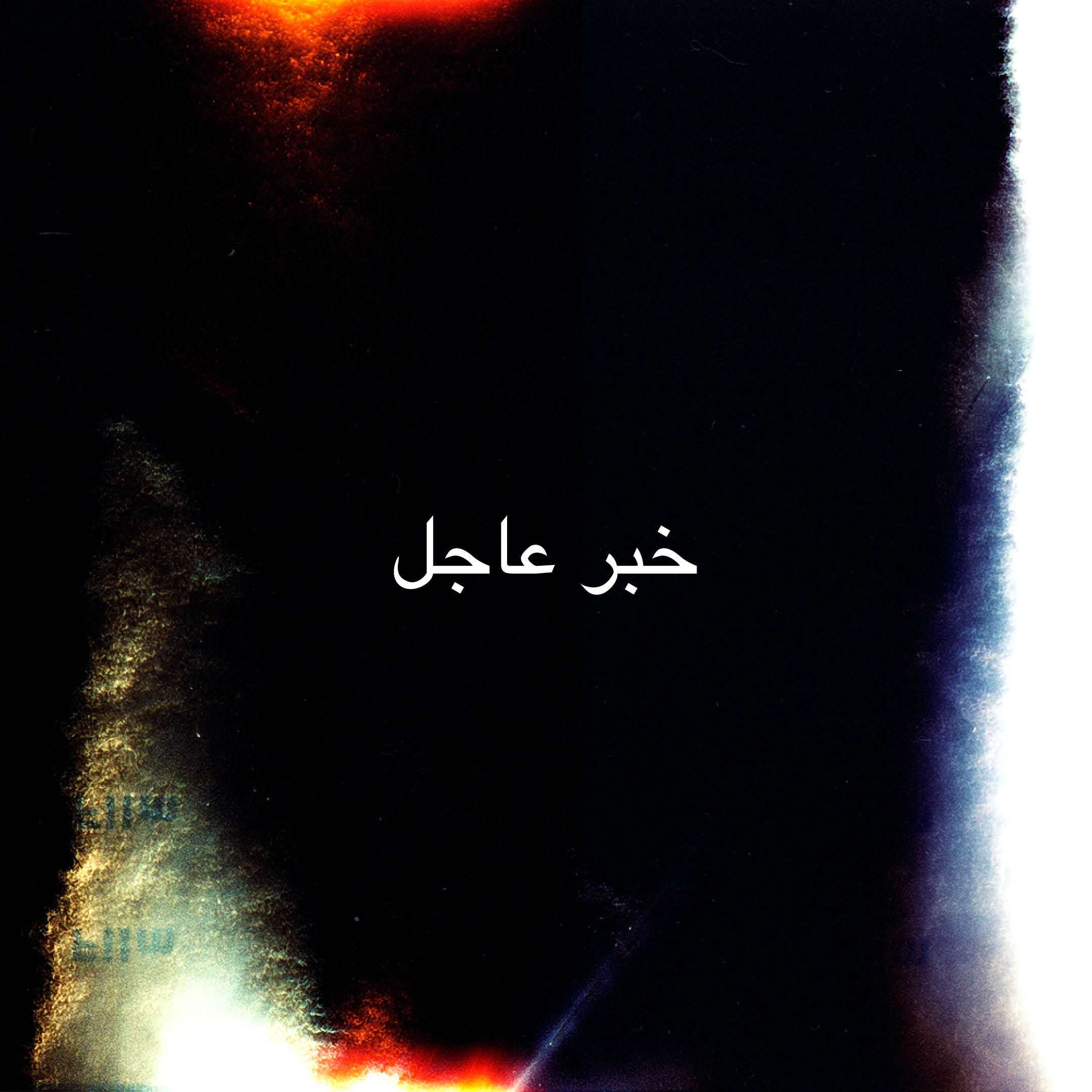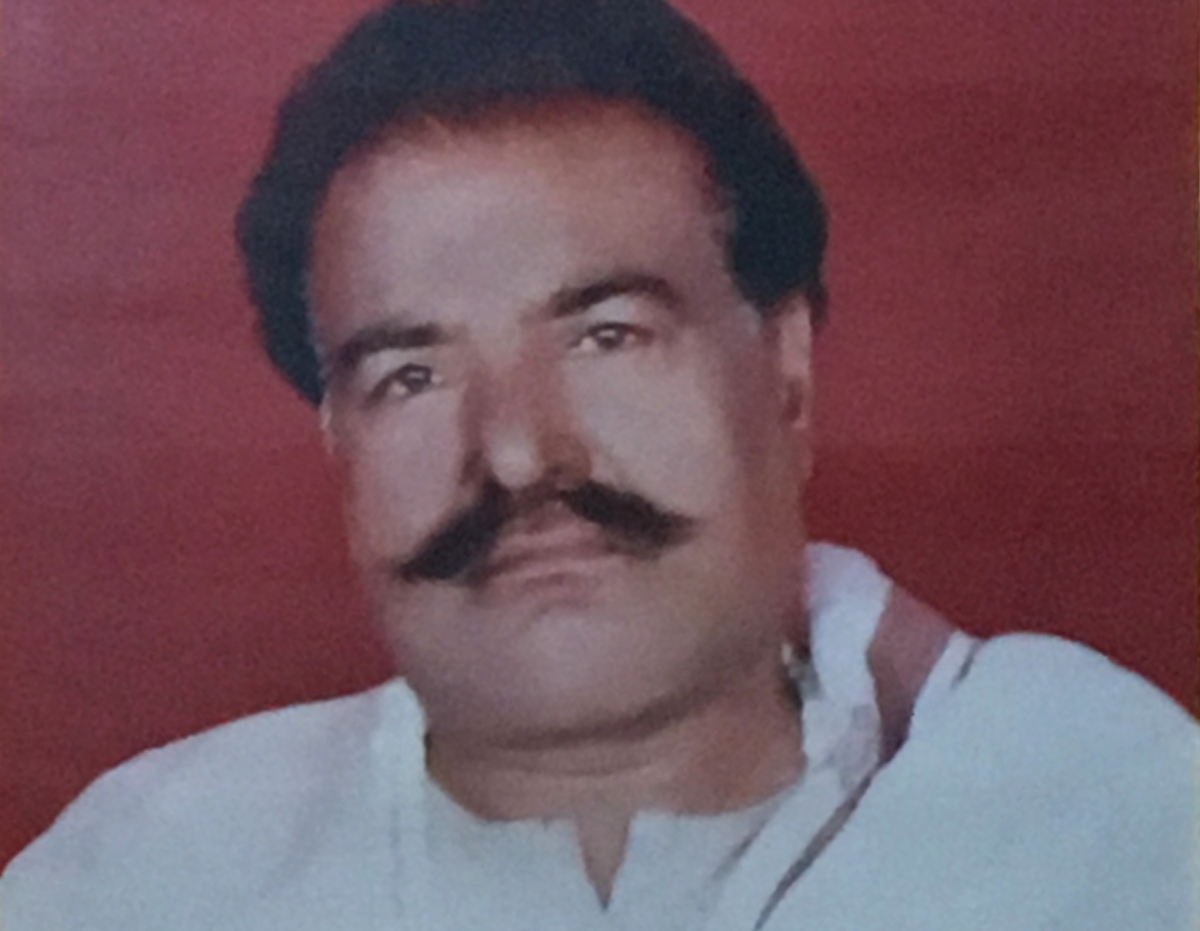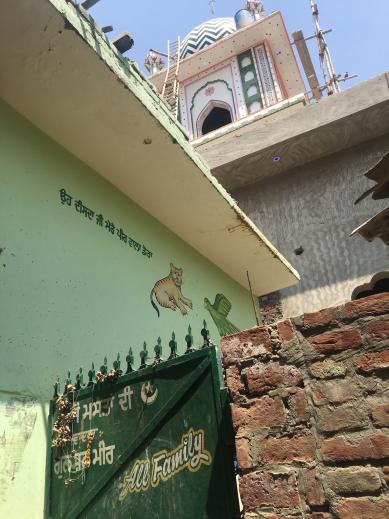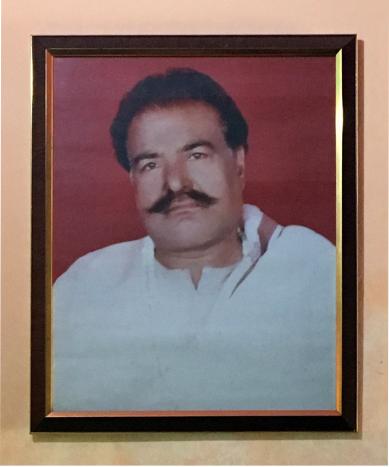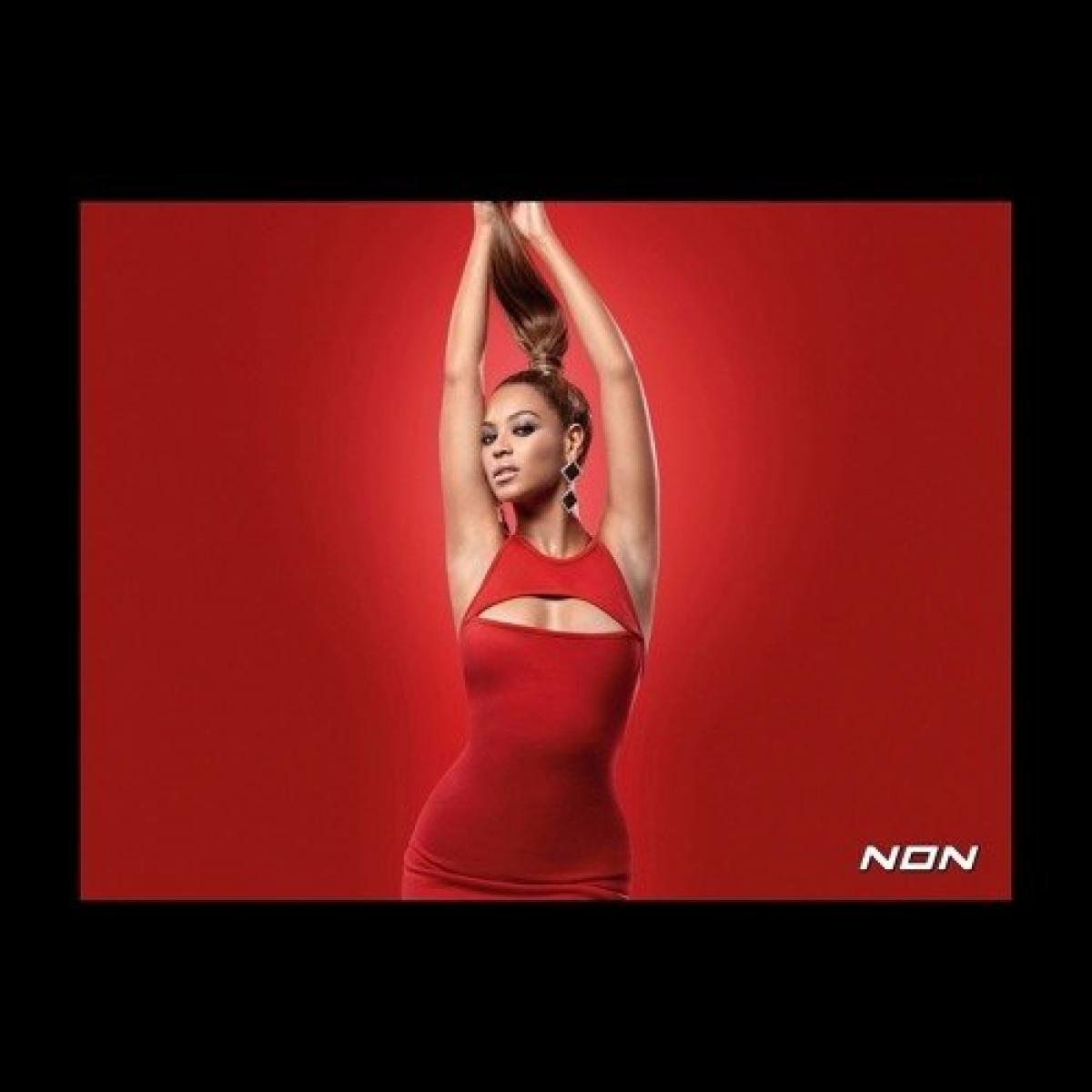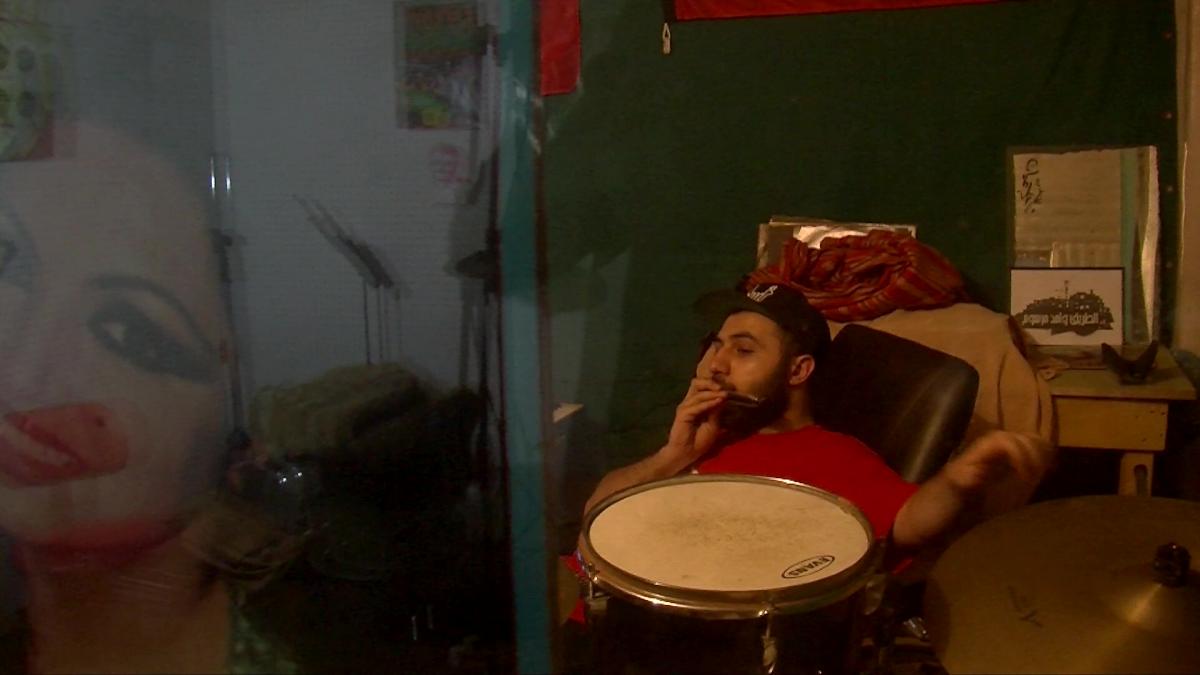
Blending Music and Politics at the Margins of Beirut
Sampling is an approach to composing music «with» others by incorporating audio fragments from various sources. In this essay, anthropologist Nicolas Puig discusses sample-based tracks by the Palestinian artist Osloob, who lived in Lebanon until he moved to Paris in 2014. This innovative rapper and electronic music composer uses sampling to link the politicized art created in refugee camps to other critical art forms that redefine the relationship between the aesthetic and the political. This article analyzes selected samples that Osloob created when he was living in Lebanon.
The creative sounds of Osloob (style in Arabic) originate in a small homemade studio in the Haret Hreik neighborhood, on the margins of Burj al-Barajné, a Palestinian refugee camp in Beirut. Until leaving for France in 2014, he reigned over his studio, composing trackât (tracks, an Arabic loan-word from English) for himself but also for his former Palestinian rap group Katibé Khamsé (Battalion Five) and partnerships and collaborations with fellow rappers in Lebanon and the Middle East. Whenever possible, rappers and instrumentalists recorded in person in his studio, but because this was not always the case they exchanged voices and sounds with Osloob digitally. He would then use these to create final versions, while seated at the controls of his «kitchen», as he called his studio in Facebook posts.
Osloob’s compositions use sampling, a method associated with rap and electronic music that creates layered musical intertextualities (Martinez 2010). As part of the field of creative productions from Palestinian refugee camps in Lebanon, sampling provides composers a means of diversifying citations, allegiances, and references, in turn enabling their music to participate in the political environment of the camps but also to maintain a connection with the global, more esoteric codes of rap and electronic music. Osloob promotes an aesthetic approach to composition that is not common in the camps and that, although sometimes accused of being exogenous or immoral by some members of political groups, seeks to be part of the wider field of contemporary politicized artistic expression. To explain the meaning of Osloob’s artistic discourse, I take an ethnographic approach to sampling by identifying his source material and describing the sound samples that Osloob uses as musical loops in his compositions.
Towards an Ethnography of Sampling
Composing with samples allows musicians to introduce unknown or forgotten music fragments, such as those in Arab and Palestinian musical traditions, into contemporary cultural productions. Sampling thus resembles a type of metonymic production that promotes memory of the past and a sense of genealogical belonging. Although Palestinian music originating in the camps tends to cultivate a sense of nostalgia (Puig 2009), electro-rap compositions of Osloob blurs timeframes, ensuring that the Palestinian situation has its place on the global cultural map as a contribution to modernity and to present-day cultural expression.
Osloob uploads all of his tracks to his Soundcloud page (Osloob1), a rich and convenient source of information about his sampling sources including titles, partnerships, and «descriptors» such as keywords or tags (#). Tags (which represent metadata referring to objects or attributes) generally identify links to other information on the web, allowing semantic elements with the same keywords to be virtually linked to each other.
In this article, information about the tracks either translated or transcribed from Arabic on Soundcloud is presented in italics.1 The samples examined here were all composed between 2011 and 2013 and represent a fraction of Osloob’s production before his emigration to France in 2014. Since then, he increasingly focuses on rhythm in his compositions while also diversifying the sources of his samples.
Arabic and Palestinian Traditions
Within Osloob’s work, Arab music and ṭarab2 first appeared in a sample of Samira Tawfiq, a member of the same generation as Farid al-Atrach and Umm Kulthum. Tawfiq is of Lebanese origin but spent most of her singing career in Syria and Jordan. Osloob’s track is named «mašhad ḥurr» and it includes an excerpt borrowed from one of Tawfiq’s songs. The track ends with a rap by Jazzar, a member of Katibé Khamsé. On Soundcloud, the track is identified as an independent artistic exercise, a kind of «free scene» (maŝhad ḥurr) that is distinct from a musical project (maŝrū’), which is more complex and involves a variety of musicians with different specialties (instrumentalists, rappers, and poets). (Osloob has reused the same title for a Soundcloud album released in 2015 with the tag «Osloob».)
This vocabulary (which I have not observed anywhere else) is an innovation that reflects Osloob’s attempts to describe his own compositions. The tag identifies the sound snippet as an «Arab sample», indicating the composer’s preference for Arab music, which he sees as a shared musical heritage (turaṭ). The track’s cover photo on Soundcloud shows Osloob’s black cap and the record The Best of Samira Toufic (Voix de l’Orient, Lebanon) on which the sample source originally appeared. This is a clear reference to Osloob’s appropriation of the original.
«mašhad ḥurr» (free scene)
In cooperation with Jazzār
Excerpt from a song by Samīra Tawfīq
Bass: Ziyād Ṣāder
Tag: Arab sample
Another track by Osloob blends Arab and Palestinian traditions: the track «Marrāt bamŝi li-ḥālī» samples a song of Kamilya Jubran, a well-known Palestinian musician who is a member of the Sabreen Palestinian orchestra based in Jerusalem. She currently lives in Switzerland, where she is focusing on a different genre of contemporary music. The songs of Sabreen belong to a vast movement of Palestinian political and national music that naturally involved sampling. One of Osloob’s and Katibé Khamsé’s goals, at least until Osloob left Lebanon and the group disbanded (the four other members are currently based in England), was to use the aesthetics of rap to renew and expand the image of music that was long associated with the national struggle (Puig 2010).
«Marrāt bamŝi li-ḥālī» (Sometimes I Walk Alone)
Musiqa/mix: Osloob
Flute: Naïssam Jalal
Bass: Ziyād Ṣāder
Voice: Louis
Sample: Kāmīlīa Jubrān/Farīd al-Aṭraŝ (Farid Al-Atrache)
Tag: Osloob
A last example of Arab and Palestinian musical indexation in Osloob’s work is this remix of the Palestinian singer Sana Moussa:
«mašhad ḥurr 2» (free scene): Remix Sanā’ Mūsā (Sana Moussa) – «hayya yammā wadda’īnī»
Flute: Naïssam Jalal
Drums: Ḥusayn Qamiḥ
Bass: Ziyād Ṣāder
Production: Osloob
Tag: Jazz fusion
Political Allegiances
Next to the reference to the ṭarab, sampling political discourses allows Osloob to manifest a political position. The choice of material links the composer and rapper to a specific political universe. The overtly political nature of Palestinian electro-rap has long been practiced by Palestinian rappers in Lebanon, although in a range of types of traditional political songs. The quote in the following track, from a speech by Georges Habache to mark the liberation of Palestinian prisoners, proclaims political allegiance to the Popular Front for the Liberation of Palestine, a secular, Marxist liberation movement. Georges Habache is an important Palestinian political figure who founded the PFL party in 1967 with Ahmad Jibril.
The opening of the album «al-ṭarīq wāḥid marsūm» (The Trail is Blazed). Self-produced CD.
Historical References
As the next track illustrates, particular samples in Osloob’s tracks recall aspects of history and Palestinian political culture that are shared in the camps in Lebanon. One example is the inclusion of a mawāl (a traditional popular song with an improvised prelude) from the soundtrack of Burhan Alawiyé’s film Kafr Qassim on Osloob’s track «biwādī». This track portrays the massacre of 47 Palestinians in a village by the Israeli border police (Kafr Qassim) during the night of October 29, 1956.
«Bi wādī» (In the valley)
The mawāl is from Kafr Qassim by filmmaker Burhan Alawiyé
Production: Osloob/Naïssam Jalal
On October 29, 1956, Zionists perpetrated the massacre of Kafr Qassim.
Another example is the reference to the massacre of Sabra and Chatila perpetrated by Christian militias under the supervision of the Israeli army in 1982.
«Ṣabra wa šatīlā/nuzūl al-rūḥ» (Sabra and Chatila/The Fall of the Soul)
Poetry: Maḥmūd Darwīŝ (Mahmoud Darwish)
Production: Osloob and Naïssam Jalal
Tag: triphop
An additional example is Osloob’s use of a sound from a news bulletin in the introductory track of Katibé Khamsé’s first album, which described events in the Nahr al-Bārid camp (Nahr el-Bared) in 2007. From June to September 2007, a three-month battle pitted the Lebanese army against a jihadist group that infiltrated the camp, displacing the entire population and leading to the camp’s destruction (although it was rebuilt later).
«ḳabar ‘ājil» (breaking news)
Min albūm Ahla fīk bilmuḳayamāt (From the album Welcome to the Camp)
Sounds from Other Sources
Although Osloob primarily samples Arab music or Palestinian oral traditions – poetry, chants, speeches, and mawāl – he sometimes borrows audio documents from more remote sources. Borrowings from New York City rap, for example, is a form of homage to the history of rap and its pioneers.
One example of this type of remix is a piece by the rapper The Notorious B.I.G. Along with Tupac Shakur (2pac) these two artists are important references for Arab rappers in the Middle East. Osloob focuses on their tracks in order to show the two musicians’ genius. The reference to the two U.S. American rappers may be related to his difficulty in being recognized for his own sample-based work as a member of a Palestinian refugee society in Lebanon. Using samples to compose music was indeed previously unknown among Palestinian musicians. Referring to the maestros of rap situates the composer in an identifiable artistic genealogy. By situating his production alongside that of the pioneers of sampling, Osloob is also using «poietic gestures» (French: gestes poïétiques, Béthune 2002, 47) to proclaim the artistic merit of his approach.
The Notorious B.I.G. – Dead Wrong
Rhythmic remi
Tag: hiphopremix
Other borrowings originate from a wide array of musical sources that are the result of Osloob’s accidental encounters with CDs or songs. The use of an excerpt from the soundtrack of the film 2046 by Hong Kar Waï in the track «Hadene aza feek» is one example of such an encounter.
«Hadīnī īza fīk» (destroy-me if you can)
From the album at-Tariq Wahid Marsum
Production: Osloob
Similarly, the connection between the camp and the desert is emphasized on another track:
From the Sahara to the camp
«Sample of a song from a Sahraoui de Mariem Hassan album»
Tags: Instrumental, Sahara, Osloob, Hiphop remix
Osloob’s Collaborations and Musical Trends in the Middle East
For Osloob, sampling is an aesthetic and political way to connect his music to other Middle Eastern musical trends. His collaborative projects show the growth of his creative palette and the increasing significance of a musical approach designed for global distribution. His projects were posted on the web in the early 2010s and remain available on both Soundcloud and Facebook.
The projects also allow him to expand his virtual global networks, which can be difficult for Palestinian musicians, for whom physical travel can be problematic. In uniting musicians of diverse origins, Osloob’s musical projects contribute to a kind of centrality-from-the-margins that is illustrated by the piece «fa/sil», which represents the struggle against living enclosed in an enclave. It is a continuous mixtape that brings together Palestinian rappers from Lebanon with the Lebanese rapper Rayess Bek and other artists from East Jerusalem, Gaza, the West Bank, Jordan, and Syria.
«fa/ṣil» (Separation)
Rhythm that breaks boundaries
Music/mix: Osloob
Flute: Naïssam Jalal
Bass: Ziyād Ṣāder/Osloob
Guitar: Ḥusām Wahbī/Ḥusayn Qameḥ
Drums: Moḥamad Hamdar. Kakhun (cajón)
Beat Box: Molotof
Rappers’ names, in order: Šāhid Ayān/Raṣaṣa/Mohamed Antar/Osloob/Abdel Jabār/Sāṭī/Edd Abbās/Maqdisī/Kāz/the poet Abderraḥman Jāsim/Sarah Abīd/Rami Jī Bī/Khāled Harārah/Yāsīn/Mawāl Dānī baldī/Waṭan/Rayīs Bīk/Naïssam Jalal
Tag: hip hop
The final example of an artistic and musical project from Osloob’s studio that bears his signature is entitled «‘alā-l-ḥifa» (in the margins or on the periphery). First promoted in a trailer (which is still available on YouTube), the project involved approximately ten Palestinian, Lebanese, and Syrian rappers and musicians and was published on Soundcloud in November 2013. Each singer and reciter (a narrator and a poet) plays a designated role in a musical narrative that uses a range of characters to illustrate the influence of the local and regional context on daily life in a neighborhood. An 18-chapter (maŝhad) musical novel, it contributed an ambitious new narrative form to rap music.
«‘alā-l-ḥifa», mašrū’ riwāyah musīqiyah īntāj osloob bil-iŝtirāk ma’ («In the margins», a project of musical novel. Production Osloob in collaboration with)
‘alā-l-ḥifah, musical novel project Abdel Jabār Khamsah (Ibrahim), Maqdisī (Abū Daūd), Ṣaṭī (Ash-shaykh), Edd Abās (the informant), Ibrāhīm Ghenayim (the neighborhood rapper), Šaks al-Alī (the annoying neighbor), Jazār (Mahmūd), firqat Qamah (client d’Ibrahim 1), the poet Abderraḥman Jāsim (Wisām al-salfī), Šāhid Ayān (Abū Ibrāhīm), Molotov (Ahmad), Ja’far al-Ṭufar (the hash dealer), Rāmī Siba’ī (the young Syrian), Osloob (the client of Ibrahim 2) and neighborhood residents.
Music/mix: Osloob
Flute: Nayssam Jalal
Guitar/bass: Ziyād Ṣāder/Osloob
Percussion in the 10th free scene: Ḥusayn Qameḥ
Keyboard: Lu’ya Ahmād 17.10.2
Cover design: Ziyād Ṣāder
Tags: hiphopmixtape, mixtape, story, album, hiphop, rap, osloob, katibe5, edd, mcgaza, palestinianfolk
Conclusion: A Critical Art Form
Pierre Shaeffer, the inventor of musique concrète, took a phenomenological approach that considers the sound in itself, independently of the context in which it was produced. This approach creates specific knowledge that bears no relationship to a sound’s semantic density. Composers such as Osloob nevertheless do not lift sound samples exclusively based on aesthetic criteria, but also based on political, social, and/or symbolic considerations that determine a borrowing strategy. The new politics of sampling generated by the arrival of electro-rap music in Palestinian camps in Lebanon reveal a shift that produces politicized art. Initially taking the form of political songs and later of committed, resistance rap, this innovative movement joins other critical approaches to using art to address contemporary issues. In Le spectateur émancipé, French philosopher Jacques Rancière wrote:
In its original sense, «critical» means that which concerns separation and discrimination. Art that is critical is art that displaces the lines of separation, inserting separation into the consensual fabric of the real and, in so doing, blurring the lines of separation that configure the consensual field of that which is given, like the line that separates a documentary from fiction: Distinction in genres that willingly separate two types of humanity: The type who suffers, and the one that acts, the one that is the object, and the one that is the subject. (Rancière 2008, 85; translation N.P.)
These musical innovations, which emerged in the mid-2000s on the Lebanese margins of Palestinian camps in Burj al-Barājna (Burj El Barajneh) or Ayn al-Ḥalūa (Ain al-Hilweh) in Saïda, represent a progressive emancipation at the crossroads of urban contexts, citizenship, and belonging that reconfigures the relationship between art and politics. By quoting archival sounds (such as news bulletins, excerpts from Arab or Palestinian songs, and historic and poetic references), Osloob’s compositions extend these innovative voices to establish a fictional field that «creates dissensus that changes the modalities of sensory presentations and forms of enunciation» (ibid., 71–72; italics N.P.).
These insights into the work of a Palestinian composer in Lebanon shed light on how a novel approach to composing music shifts aesthetic boundaries and assigns new meanings to pre-existing sounds. This technique blends music and politics, not to reference other artistic practices that provide energy to the political, but because «art’s relationship to politics is not a passage from fiction to the real, but a relationship between two ways of producing fictions» (ibid., 84). Artistic practices – in this case, musical composition – are constructed against consensus in order to provide dissonance, in other words, to forge «forms of polemical common sense» (ibid.). Osloob’s music, composed on the margins of Beirut, is central because it acts as a prism that refracts space and time, articulating the artistic and the aesthetic with the political by integrating sounds from long ago and from far away.
- 1. The transcriptions follow Ideo/Ifao conventions, while original Roman script is preserved, such as the names «Osloob» or «Naïssam Jalal».
- 2. The music of the Golden Age of Egyptian/Arabic music during the twentieth century, of which the great diva Umm Kulthum is one the most famous representatives.
List of References
This article is adapted from Puig 2017. It was translated from French to English by John Angell.
This article is part of Norient’s online publication Sampling Politics Today, published in 2020 as part of the research project «Glocal Sounds – Re-Working and Re-Coding Place References» (No. 162797), funded by the Swiss National Science Foundation (SNSF) and supported by the Bern University of the Arts HKB.
Bibliographic Record: Puig, Nicolas. 2020. «Blending Music and Politics at the Margins of Beirut». In Sampling Politics Today, edited by Hannes Liechti, Thomas Burkhalter, and Philipp Rhensius (Norient Sound Series 1). Bern: Norient. DOI: 10.56513/nftg6449-7.
Biography
Published on September 24, 2020
Last updated on April 09, 2024
Topics
Sampling is political: about the use of chicken clucks or bomb sounds in current music.
What happens, when artists move from one to another country? For example, when an Arab artist replaces the big tractors in her the village with big jeeps of the West.
Why New Yorks’ underground doesn’t give a fuck about Trump or why satirical rap in Pakistan can be life threatening.
A form of attachement beyond categories like home or nation but to people, feelings, or sounds across the globe.
Special
Snap
